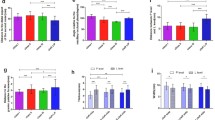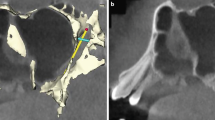Abstract
Purpose
This study aimed to locate the inferior end (Pti) and the superior end (Pts) of pterygomaxillary junction (PMJ) relative to anterior nasal spine (ANS) so as to provide references for pterygomaxillary separation.
Methods
The study was based on CBCT images of 109 Chinese patients. We projected Pti and Pts to the frontal plane and measured the distance as well as the positional relationship between the projection points and ANS via three-dimensional reconstruction image.
Results
On average, the ANS was 5.18 mm above the Pti and the horizontal distance between the Pti and ANS was 21.86 mm. The horizontal and vertical distances between Pts and ANS was 20.41 mm and 10.91 mm, respectively. The vertical height of PMJ was 16.09 mm. Scatter plots diagrammatic centered on ANS showed that 73% (160/218) Pti and 64% (140/218) Pts appeared in a 45° fan shape ranged from 20 to 25 mm radius in bilateral inferior and superior quadrant, respectively. There was no significant difference in the distance between both sides (P > 0.05).
Conclusion
During the pterygomaxillary disjunction, it exists a risk of injuring neurovascular bundle of the pterygopalatine fossa 16.09 mm above the lowest border of the pterygomaxillary junction. The region within a 45° fan shape ranged in 20–25 mm radius in inferior quadrant centered on ANS might be suitable for the osteotome position. The positional relationship especially between the ANS and Pti found in this study provides a reference for surgeons during pterygomaxillary disjunction.



Similar content being viewed by others
Data availability
All data generated or analyzed during this study are included in this published article.
References
Apinhasmit W, Chompoopong S, Methathrathip D, Sangvichien S, Karuwanarint S (2005) Clinical anatomy of the posterior maxilla pertaining to Le Fort I osteotomy in Thais. Clin Anat 18:323–329. https://doi.org/10.1002/ca.20131
Bendrihem R, Vacher C (2017) Radiologic anatomy of the maxillary artery in the pterygopalatine area applied to Le Fort 1 osteotomies. Surg Radiol Anat 39:23–27. https://doi.org/10.1007/s00276-016-1697-7
Bendrihem R, Vacher C, Fohlen A, Pelage JP (2017) Anatomic basis of Le Fort 1 impaction osteotomy: a radiological study. Surg Radiol Anat 39:1209–1214. https://doi.org/10.1007/s00276-017-1870-7
Carvalho PHA, Moura LB, Trento GS, Holzinger D, Gabrielli MAC, Gabrielli MFR, Pereira Filho VA (2020) Surgically assisted rapid maxillary expansion: a systematic review of complications. Int J Oral Maxillofac Surg 49:325–332. https://doi.org/10.1016/j.ijom.2019.08.011
Cheng LH, Robinson PP (1993) Evaluation of a swan's neck osteotome for pterygomaxillary dysjunction in the Le Fort I osteotomy. Br J Oral Maxillofac Surg 31:52–53. https://doi.org/10.1016/0266-4356(93)90101-2
Cheung LK, Fung SC, Li T, Samman N (1998) Posterior maxillary anatomy: implications for Le Fort I osteotomy. Int J Oral Maxillofac Surg 27:346–351. https://doi.org/10.1016/s0901-5027(98)80062-3
Chin Y-P, Leno MB, Dumrongwongsiri S, Chung KH, Lin H-H, Lo L-J (2017) The pterygomaxillary junction: an imaging study for surgical information of LeFort I osteotomy. Sci Rep 7:9953–9953. https://doi.org/10.1038/s41598-017-10592-8
Colreavy MP, Baker T, Campbell M, Murphy M, Lyons B (2001) The safety and effectiveness of the Le Fort I approach to removing central skull base lesions. Ear Nose Throat J 80(315–318):320
Gulses A, Oren C, Altug HA, Ilica T, Sencimen M, Erdemci F, Gider IK, Dogan N (2014) A new preoperative radiological assessment in LeFort I surgery: anterior nasal spine-sphenoidal rostrum. Oral Maxillofac Surg 18:197–200. https://doi.org/10.1007/s10006-013-0401-x
Juniper RP, Stajcić Z (1991) Pterygoid plate separation using an oscillating saw in Le Fort I osteotomy. Technical note. J Craniomaxillofac Surg 19:153–154. https://doi.org/10.1016/s1010-5182(05)80304-x
Lewark TM, Allen GC, Chowdhury K, Chan KH (2000) Le Fort I osteotomy and skull base tumors: a pediatric experience. Arch Otolaryngol Head Neck Surg 126:1004–1008. https://doi.org/10.1001/archotol.126.8.1004
Neema B, Olabu BO, Butt FMA, Idenya PM, Cheruiyot I, Misiani M (2020) Computed tomography scan assessment of the anatomy of the pterygomaxillary junction and its relevance in Le Fort I osteotomy. J Craniofac Surg. https://doi.org/10.1097/scs.0000000000006588
Nunn ME, Fish MD, Garcia RI, Kaye EK, Figueroa R, Gohel A, Ito M, Lee HJ, Williams DE, Miyamoto T (2013) Retained asymptomatic third molars and risk for second molar pathology. J Dent Res 92:1095–1099. https://doi.org/10.1177/0022034513509281
Odabaşı O, Erkmen E, Özlem Üçok C, Akif Bakir M, Yıldızer Keriş E, Şahin O (2020) Morphometric analysis of pterygomaxillary region by using cone beam computed tomography. J Stomatol Oral Maxillofac Surg. https://doi.org/10.1016/j.jormas.2020.06.006
Scolozzi P, Herzog G (2014) Total mandibular subapical osteotomy and Le Fort I osteotomy using piezosurgery and computer-aided designed and manufactured surgical splints: a favorable combination of three techniques in the management of severe mouth asymmetry in Parry-Romberg syndrome. J Oral Maxillofac Surg 72:991–999. https://doi.org/10.1016/j.joms.2013.09.044
Susarla SM, Ettinger RE, Egbert MA (2020) Transmucosal pterygomaxillary separation in the Le Fort I osteotomy. Plast Reconstr Surg 145:1262–1265. https://doi.org/10.1097/prs.0000000000006751
Taylor JA, Maercks RA, Jones DC, Gordon CB (2009) Endoscopically assisted Le Fort I osteotomy using an ultrasonic scalpel: a feasibility study in cadavers. J Oral Maxillofac Surg 67:1420–1424. https://doi.org/10.1016/j.joms.2008.12.058
Acknowledgements
This work was supported by the Key Research and Development Program of Jiangsu Province (BE2017732) and the Priority Academic Program Development of Jiangsu Higher Education Institutions (PAPD, 2018-87).
Funding
This work was supported by the Key Research and Development Program of Jiangsu Province (BE2017732) and the Priority Academic Program Development of Jiangsu Higher Education Institutions (PAPD, 2018-87).
Author information
Authors and Affiliations
Contributions
XC and JZ carried out the measurements and drafted the manuscript; XC and YH collected data, analyzed and interpreted the results; XC and SG were involved in the statistical analysis; HJ managed the measurement design, reviewed the manuscript and provided funding support. All authors read and approved the final manuscript.
Corresponding author
Ethics declarations
Conflict of interest
The authors declare that they have no conflict of interest.
Ethical approval
All procedures performed in studies involving human participants were in accordance with the ethical standards of the institutional and/or national research committee and with the 1964 Helsinki Declaration and its later amendments or comparable ethical standards. This study was approved by the local ethics committee (No: PJ2017-048-001) of the Affiliated Stomatological Hospital of Nanjing Medical University.
Informed consent
Informed consent was obtained from all individual participants included in the study.
Additional information
Publisher's Note
Springer Nature remains neutral with regard to jurisdictional claims in published maps and institutional affiliations.
Electronic supplementary material
Below is the link to the electronic supplementary material.
Rights and permissions
About this article
Cite this article
Chen, X., Zhu, J., Guo, S. et al. CBCT study on the positional relationship between marginal points of pterygomaxillary junction and anterior nasal spine. Surg Radiol Anat 43, 219–224 (2021). https://doi.org/10.1007/s00276-020-02582-9
Received:
Accepted:
Published:
Issue Date:
DOI: https://doi.org/10.1007/s00276-020-02582-9




